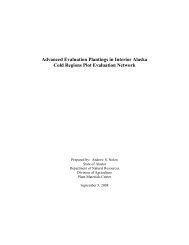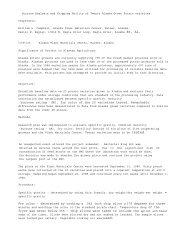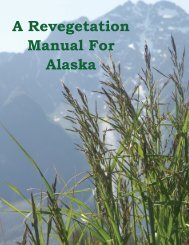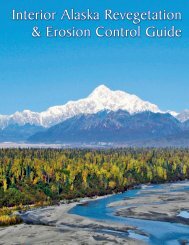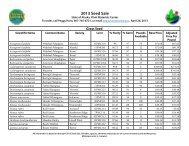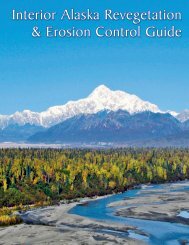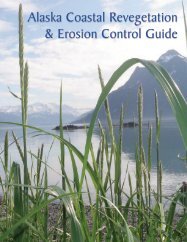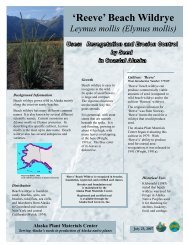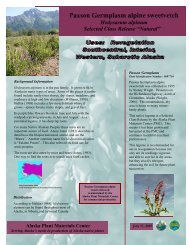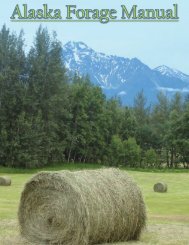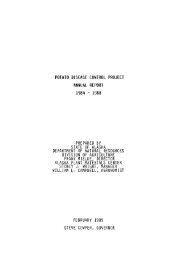Alaska Forage Manual - Alaska Plant Materials Center - State of ...
Alaska Forage Manual - Alaska Plant Materials Center - State of ...
Alaska Forage Manual - Alaska Plant Materials Center - State of ...
Create successful ePaper yourself
Turn your PDF publications into a flip-book with our unique Google optimized e-Paper software.
SIBERIAN WILDRYE<br />
Photo: Casey Dinkel, AK PMC<br />
<strong>Forage</strong> Value<br />
Siberian Wildrye has marginal forage quality. This grass<br />
also has poor digestibility due to large amounts <strong>of</strong> lignin,<br />
cellulose and hemicellulose. It has a protein content similar<br />
to Polar Brome (Bromus inermis), Slender Wheatgrass (Elymus<br />
trachycaulus), and Timothy (Phleum pratense), after the first<br />
year <strong>of</strong> establishment. Like most forage grasses, Siberian<br />
Wildrye nutrient levels are highest just before the plant<br />
develops its seedhead. There is limited Siberian Wildrye<br />
research data available concerning actual nutritional value,<br />
palatability, and grazing utilization.<br />
Distribution and Adaptation<br />
Siberian Wildrye seedhead<br />
Siberian Wildrye<br />
Elymus sibiricus (L.)<br />
Description<br />
Elymus sibiricus (Siberian Wildrye) is a tall growing, erect<br />
perennial bunchgrass, that grows from 75 - 90 centimeters<br />
(30 to 36 inches) in height. It is a cool season species native<br />
to fragmented intermountain areas. Siberian Wildrye can be<br />
easily identified by its long, lax, drooping seedhead. This grass<br />
species produces an abundance <strong>of</strong> seed, and has a conspicuous<br />
ability to grow in open, unshaded and infertile sites. Siberian<br />
Wildrye is known for its extreme winter hardiness and excellent<br />
seedling vigor. It produces approximately 127,000 seeds per<br />
pound <strong>of</strong> seed.<br />
Uses<br />
Livestock: Siberian Wildrye can be utilized as hay or as a<br />
pasture crop. It is used by cattle, horses, and sheep. The<br />
palatability <strong>of</strong> Siberian Wildrye is moderate to low for most<br />
classes <strong>of</strong> livestock.<br />
Wildlife: A large variety <strong>of</strong> wildlife utilize Siberian Wildyre<br />
for cover. Most wildlife will not typically utilize this grass for<br />
feed as <strong>of</strong>ten as domestic livestock. Siberian Wildrye has low<br />
palatability for elk, bison and various species <strong>of</strong> waterfowl.<br />
Siberian Wildrye is distributed across Europe, Asia, Russia,<br />
and parts <strong>of</strong> Canada and <strong>Alaska</strong>. It can be found growing in<br />
sandy soils, in areas receiving between 24 and 55 inches <strong>of</strong><br />
annual precipitation. Siberian Wildrye is a very drought<br />
tolerant species and will not grow well in wet areas or areas<br />
with poorly drained soils. The grass is adapted to slightly acid<br />
to neutral soils, with a pH range from 5.0 to 7.2. Siberian<br />
Wildrye will not tolerate saline soils or shaded environments.<br />
Culture<br />
An average broadcast seeding rate for Siberian Wildrye is<br />
12 lbs/acre. A rate <strong>of</strong> 6 lbs/acre should be used when drill<br />
seeding or when seeded in a mixture. Siberian Wildrye seeds<br />
should be planted at a depth <strong>of</strong> 1 /4 in. to 1 in. Seed should<br />
be planted in medium to coarse textured, well drained soil if<br />
possible. All seeding rates are determined by using Pure Live<br />
Seed (PLS) calculations, as described in Appendix B.<br />
Appropriate fertilizer ratios depend upon soil type, chemistry,<br />
and location. Soil samples should be collected and analyzed<br />
before fertilizer is applied. Little information is available<br />
regarding the effect fertilizer and irrigation may have on<br />
Siberian Wildrye yields.<br />
Management<br />
Siberian Wildrye appears to be a good forage species,<br />
although more research is needed to determine its overall<br />
value. There are several potential problems for growers<br />
dealing with Siberian Wildrye. This grass possesses a needle<br />
like appendage or awn that could potentially be harmful to<br />
livestock. Siberian Wildrye should not be grazed within the<br />
first year <strong>of</strong> its planting. Grazing could potentially destroy or<br />
diminish its life span. During its first year <strong>of</strong> growth, Siberian<br />
Wildrye does not produce a high overall yield. There has been<br />
little research into pests (such as insects, mildews, or rust) that<br />
could be harmful to Siberian Wildrye.<br />
51



